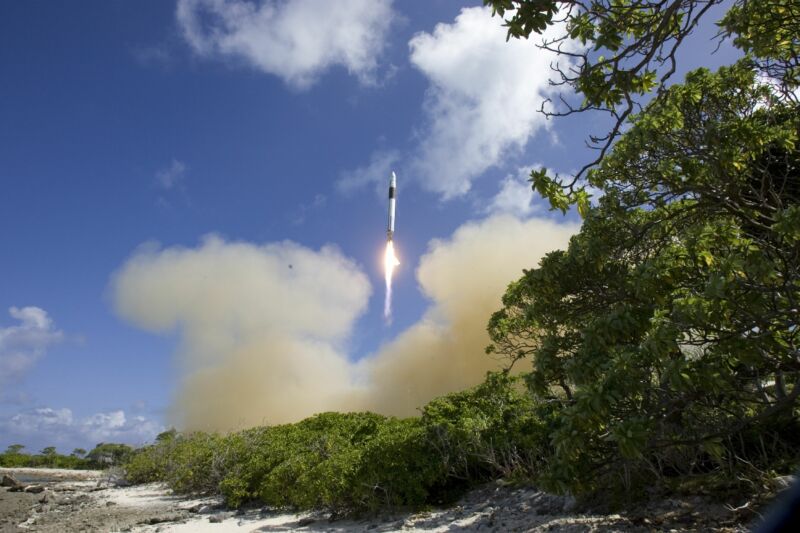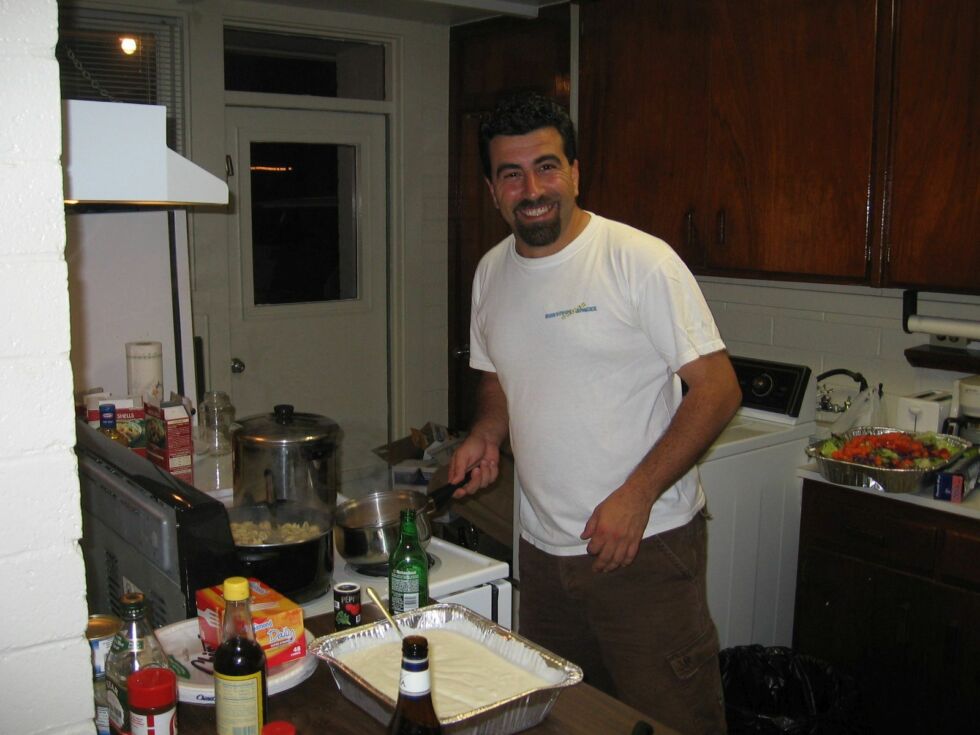
By the time of Flight Three, the SpaceXers had grown accustomed to their visits out to the central Pacific Kwajalein Atoll for launches. Over the course of three years, they learned how to survive in the tropical environment and even enjoy island life. Some of these lessons were hard won, however.
Fairly early on during the Kwaj experience, engineer Brian Bjelde missed the evening boat back to Kwajalein. It happened. He and a few others slept under the stars, passing a perfectly pleasant night. But the next morning, Bjelde lacked a change of clothes. So he grabbed a T-shirt from a package of Falcon 1 swag items that had shown up in Omelek. The vacuum-packed, white T-shirt may have been wrinkled, but at least it was clean, and it kept the sun off his back. Bjelde went through massive quantities of sunscreen every day—any piece of skin exposed to the tropical sun was covered. Throughout that day, as he slathered himself in it, Bjelde noticed the T-shirt’s wrinkles straightening beneath the island’s heat and humidity.

Late in the afternoon, he went to take a shower. “I took my shirt off, and I had the worst sunburn of my life through the t-shirt,” he said. “I had a perfect sunburn. I think the end of my days will come through skin cancer because of that Kwajalein experience. The sunshine went straight through that cheap white T-shirt. I just didn’t think to put sunscreen underneath it. Why would you?”
The heat and humidity punished those on Omelek in other ways. Bjelde had been a California kid, where it sometimes got hot but rarely so humid. And he had never done this kind of physical labor before.
Marines out at sea may be familiar with crotch rot, but Bjelde had never heard of it. “I don’t claim to be thin or skinny, and if your thighs rub a little bit, and then you sweat, it leads to chafing,” he said. “But the salty, humid environment just made things worse.”
As he struggled to move around one day, walking bow-legged across the island, Bjelde asked the more experienced Chris Thompson what he should do about his painful ailment. Did he need penicillin, perhaps? Thompson, a former Marine, explained the trick of rubbing underarm deodorant between the legs. And Thompson offered another useful suggestion: switching from boxers to boxer briefs.
The few women on the island faced their own travails. In the early years, Anne Chinnery and Flo Li had little privacy and no running water. Using the island’s toilet necessitated filling a bucket with sea water first so the toilet could be flushed. Showers were even more rudimentary. Initially, the SpaceXers filled a trash bucket with water to wash their hands. When she got really hot and sweaty at the end of a long day. Li said she would put on a bathing suit and dump the rain water over her head to rinse off.
As the Flight One campaign progressed in 2006, the small team moved on from a trash can to a camp shower. They collected rainwater in large, black bags, and then laid the bags out on the helipad to warm up during the daytime. One of these bags would be dragged onto a stand so that it hung over a folding metal chair, allowing for the luxury of a warm shower. For the benefit of Chinnery and Li, a shower curtain afforded a measure of privacy.
-
Close-up of Falcon 1 rocket before Flight Three.Hans Koenigsmann
-
Rolling the Falcon 1 rocket from the hangar to the launch site before Flight Three.
-
The Peregrine Falcon docked at Omelek Island.Rita Hachmann
-
Heading home from Omelek Island back to Kwaj, it's time to hang loose.Hans Koenigsmann
-
Brian Bjelde with the C-17 aircraft used for Flight Four.Brian Bjelde
Fun in the Sun
The engineers and technicians worked hard during the daytime, but as the sun neared the horizon, the crews would often take a break. They’d swim; a few people even skinny-dipped in the lagoon as a final escape from the heat.
Sometimes their efforts at rowdy fun would go awry. Omelek was small enough to walk across in a few minutes, but during later flight campaigns there was an old, raggedy golf cart for employee use. Zach Dunn described it as a “serious turd,” hung together with baling wire and bubblegum. At some point between Flights Two and Three, the brakes went bad on the cart, but when the launch team returned from Los Angeles no one realized it.
At the end of one workday, as some of his friends caught the boat back to Kwaj, Dunn decided to see them off in style. He hopped onto the cart, parked near the trailers for overnighters, and put the pedal to the metal. Dunn thought it would be fun to zoom past his departing friends, honking and waving. He had built up a good bit of speed as he neared the dock, and in preparation to salute the boat, Dunn decided he had better slow down. In a slapstick moment straight out of a cartoon, when Dunn pushed on the brake pedal it went down to the floor without any resistance. He succeeded in getting his comrades’ attention, but for the wrong reasons, as he began screaming and careening toward a small rocky ledge. From there, Dunn faced a clear shot into the lagoon, likely flipping end over end as he went. He made a split-second decision and veered toward a palm tree instead.
“Instead of seeing me waving and honking and being a general goofball, they just saw me drive out at full speed, no explanation whatsoever,” Dunn said of the group on the boat. “Then I crashed into a palm tree at top speed.”
The impact threw Dunn over the cart’s steering wheel, but he walked away from the accident. The employees on the boat laughed uproariously.
Some SpaceXers who stayed overnight fished the coral reefs surrounding Omelek, though they released anything they caught. Small organisms that grow on tropical coral reefs produce ciguatoxin, which accumulates in small fish and in greater concentrations in larger fish on up the food chain. The Marshallese people developed an immunity to the toxin, but it causes severe food poisoning in outsiders. Every now and then the SpaceXers would hear a report of a visitor to Kwaj dying after eating a reef fish.
There were natural threats on land, too. Coconut crabs, which can grow up to three feet in length and are the largest arthropods in the world, lived on Omelek. Sometimes, they would be seen scurrying up a tree and using strong pincers to knock a coconut to the ground. Then, back on the ground, the crab would crack open the coconut. “There was definitely no sleeping naked on the beach for us,” said Jeff Richichi, a structures engineer.
By the time of Flight Three, the Omelek engineers and technicians had continued to refine their environment, especially with better food for those who slept on the island. In the double-wide’s kitchen, they would take turns cooking meals that outclassed the fare in the Army cafeteria on Kwaj. In the mornings, they feasted on steaming plates of scrambled eggs. In the evenings, they mixed it up. Bulent Altan and a new launch engineer, Ricky Lim, did a lot of the cooking because they enjoyed it. It might be grilled steaks one night or shrimp in paprika sauce the next. Altan’s specialty was a Turkish goulash he loved to bake, mixing pasta with garlic and yogurt, smothered in a butter-and-tomato sauce. It proved a crowd pleaser on Omelek. There were other comforts, too. A refrigerated sea van had an endless supply of drinks, including beer for the evenings.
“Everything was fantastic luxury compared to the first flight, so we loved it on Omelek,” Altan said. “After the really, really crazy days everyone gathered around at dinnertime and really enjoyed just sitting down and relaxing. We would always watch the same movies over and over again, like Starship Troopers. The most important thing is that the camaraderie was great.”
The overnighters also built a wooden deck attached to the trailer. From there, they could survey some of the darkest skies on Earth. Oftentimes, clouds obscured their view. But when it was clear, there were a million brilliant stars. Sometimes there were artificial stars, too. They looked like shooting stars but didn’t fade out. Rather, they brightened—because these were intercontinental ballistic missiles being shot from the mainland United States toward Kwajalein Atoll.
It was a great irony: the imperative to fly fast pushed SpaceX from Vandenberg to Kwajalein, and once there, the employees had a grand view of missiles launched from Vandenberg. For the better part of half a century, the small atoll had served as ground zero for the development of intercontinental ballistic missiles and, later, President Ronald Reagan’s “Strategic Defense Initiative.” The Army’s facilities on Kwajalein still serve a number of purposes, but the most enduring one is acting as a giant target range.
When the Air Force wants to test the accuracy of a Minuteman III missile, it will launch the three-stage, solid-fueled rocket from Vandenberg toward Kwaj. With its sophisticated radars, cameras, and other tracking equipment, the Reagan test site in Kwaj captures precise radar and optics data about the missile as it streaks through the atmosphere at about four miles per second. Often, the missiles targeted Illeginni Island on the western side of the atoll. This means they passed almost directly over Omelek, on the eastern rim of the chain of islands. From there, SpaceXers spending the night on Omelek marveled as these missiles came in. Nearing Kwajalein, the missile’s third stage would drop off, leaving only the missile bus, carrying the simulated warheads.
For some of the older hands on Kwaj, the prospect of incoming ballistic missiles rekindled distant memories of the Cold War. Seeing those rockets come in was beautiful but also a little terrifying, knowing that if a real warhead was on board death would be imminent. “The simulated bombs would split off like little fireflies,” Chinnery said. “It was very eerie to see those. It reminded me of growing up and being scared of nuclear annihilation.”
Another advantage of spending the night in the double-wide trailer was skipping morning rush hour and catching a few more winks. The big catamaran that carried Boeing employees from Kwaj to Meck Island, and then dropped off SpaceX workers at Omelek, was reliable. But it got an early start, leaving the dock at 6:05 a.m. This meant that Buzza’s team had to rise early if they wanted to eat breakfast before riding across Kwaj to the pier to catch a ride.
“I never missed that boat, ever,” Buzza said. “But sometimes, teammates would. The Army is very punctual and would not deviate. Except for one time, they did come back to the dock for Elon.”
reader comments
147